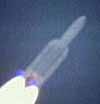| . |  |
. |
 Washington DC - Nov 25 , 1997 - Today in Kourou, French Guiana, Mr Fredrick Engstr�m, ESA Director of Launchers, Mr Michel Courtois, Deputy Director-General of CNES and Mr Jean-Marie Luton, Chairman of Arianespace signed the document formally handing over Ariane launch complex ELA-3 from ESA to Arianespace.
Washington DC - Nov 25 , 1997 - Today in Kourou, French Guiana, Mr Fredrick Engstr�m, ESA Director of Launchers, Mr Michel Courtois, Deputy Director-General of CNES and Mr Jean-Marie Luton, Chairman of Arianespace signed the document formally handing over Ariane launch complex ELA-3 from ESA to Arianespace.Representing an investment of some 800 million ECU, ELA-3 is by far the largest installation built by ESA under the Ariane-5 development programme. CNES was responsible for its design, construction and operation during cryogenic main stage testing and the first two qualification flights, in its capacity as prime contractor for the development of the Ariane-5 launcher and launch facilities. Arianespace will now take over responsibility for ELA-3 operations, including launcher integration and launch operations, final payload preparation, management and maintenance of facilities, insurance, safety and quality control, in addition to the similar responsibilities it has discharged since 1986 for the ELA-2 complex dedicated to Ariane-4. Preparations for the hand-over of ELA-3 management responsibility to Arianespace had been under way for some years, with the progressive integration of Arianespace engineers and technicians into the CNES teams, to ensure that personnel training was properly completed following execution of the first two Ariane-5 qualification flights. Particular attention has been paid to the industrial set-up in order to secure a coherent and optimised structure meeting ELA-2 and ELA-3 operations & maintenance requirements. To that end, Arianespace is contracting the same European companies which have hitherto been working under CNES contracts. Twelve firms (from Belgium, France, Germany, Italy and Spain) provide some 250 specialists under operations & maintenance contracts for the fluids and mechanical systems, computerised checkout systems, power supply and air conditioning. Arianespace also draws on the Guiana Space Centre's support services for Ariane-5 launch campaigns, on the same basis as for Ariane-4 launches. These support activities, managed by CNES on behalf of ESA with European contractors, include coordination of overall launch range operations, ground and inflight safety, tracking and telemetry stations, meteorology, telecommunications, operations & maintenance for payload preparation facilities and logistical facilities. Main features of ELA-3 The ELA-3 complex covers a 15 square km (3 x 5 km) area of land located close to Ariane-4 launch complex ELA-2 and 25 km north-west of Kourou. It is designed to handle a launch rate of eight to ten Ariane-5 launches per year at one month intervals. The duration of a standard launch campaign will be 22 working days, once the necessary learning phase is over. The basic ELA-3 design differs from that of earlier Ariane launch complexes in that there is no mobile servicing gantry or umbilical mast in the launch zone. This enhances the availability of the launch facilities and simplifies the launch zone itself, reducing its vulnerability in the event of an accident. Construction work on ELA-3, which started in 1988, involved some two million man-hours and sixty European companies providing the requisite engineering design, construction and test expertise in the following areas: infrastructures, power supply, air conditioning, mechanical structures, specialised tooling, ground-to-launcher connections, cryogenic and conventional fluids, computerized checkout systems, inspection, etc. ELA-3 consists of two zones:
ELA-3 also comprises a 4 km twin railtrack for launcher roll-out and one mobile launch table with an integrated umbilical mast (a second table is due to be delivered in 1998). Each launch table weighs 870 tonnes unladen, supports the launcher throughout its preparation campaign and is fitted with a two-part 58 m high umbilical mast. The launch table/launcher assembly, weighing 1500 tonnes, is towed by truck from the final assembly building to the launch zone. In-transit power, ventilation and air- conditioning requirements are met by a special servicing unit, while a damper is used to absorb the energy generated by the action of the wind on the launcher. Between 1994 and 1996, the ELA-3 facilities were satisfactorily used for a series of main stage firing tests, which ground-qualified the stage and the ground facilities. The first two Ariane-5 qualification campaigns (501 and 502) proceeded without major technical problems regarding the ELA-3 ground facilities, which, with the improvements made to ange facilities (safety, telemetry, downrange stations, etc.), are therefore considered as qualified. With the ELA-3 launch complex, other Ariane-5-dedicated production and test facilities built during the development phase are being handed over by ESA to the industrial operators at the Guiana Space Centre:
|
| |||||||||
| The content herein, unless otherwise known to be public domain, are Copyright 1995-2016 - Space Media Network. All websites are published in Australia and are solely subject to Australian law and governed by Fair Use principals for news reporting and research purposes. AFP, UPI and IANS news wire stories are copyright Agence France-Presse, United Press International and Indo-Asia News Service. ESA news reports are copyright European Space Agency. All NASA sourced material is public domain. Additional copyrights may apply in whole or part to other bona fide parties. Advertising does not imply endorsement, agreement or approval of any opinions, statements or information provided by Space Media Network on any Web page published or hosted by Space Media Network. Privacy Statement All images and articles appearing on Space Media Network have been edited or digitally altered in some way. Any requests to remove copyright material will be acted upon in a timely and appropriate manner. Any attempt to extort money from Space Media Network will be ignored and reported to Australian Law Enforcement Agencies as a potential case of financial fraud involving the use of a telephonic carriage device or postal service. |